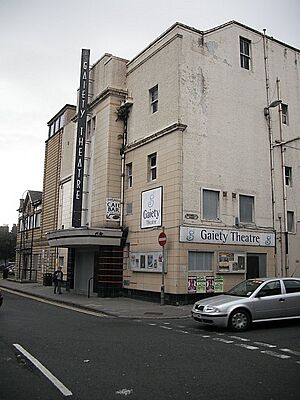Gaiety Theatre, Ayr facts for kids
The Gaiety Theatre is a special building in Ayr, Scotland. It is a place where people can watch live shows. The theatre is known for its beautiful inside design and how good the sound is. It's a very old and important building for the town.
Contents
The Gaiety Theatre's Story
How the Theatre Began
The Ayr Gaiety Theatre was first built in 1902. It had to be rebuilt after a fire in 1904. The front of the building was changed in 1935. Another fire in 1955 meant more repairs were needed. In 1995, a new part was added. This included a café, ticket office, and rooms for performers.
The Popplewell Family Years
After a tricky start, the theatre was used as a cinema for a while. Then, a man named Ben Popplewell bought it. He was good at running theatres. For 50 years, his family managed the Gaiety. During this time, the theatre became famous for its "summer variety show" called the Gaiety Whirl. This show ran for many weeks each year. Many famous Scottish and UK performers started their careers there. The theatre also showed other plays, including Shakespeare.
Becoming a Council Theatre
In 1974, the local Council took over the theatre. It continued to offer family-friendly shows, like the popular Christmas pantomime. The theatre also started to show a wider range of performances. After many successful years, fewer people started coming to the shows. The Council decided a new plan was needed. In January 2009, the theatre closed. This left Ayr without a theatre.
The Theatre's Closure and Reopening
Why the Gaiety Closed
Many people in Ayr were very upset when the Gaiety Theatre closed. They worried it would not open again. More than 400 people went to a public meeting. The future of the theatre was a big topic in the news. Many Scottish performers also shared their sadness. People talked a lot about it online too.
A New Beginning: Ayr Gaiety Partnership
In 2009, the Council asked groups to take over the theatre. A charity called Ayr Gaiety Partnership (AGP) was formed by local people. They wanted to reopen the theatre. After more than three years, AGP got money from the Council and the Scottish Government. They also raised money locally. In 2012, AGP took over the theatre. Their goal was to make the Gaiety a central place for arts in South Ayrshire. They wanted to help the area's culture and economy.
The Grand Reopening in 2012
The first goal for AGP was to reopen with a successful pantomime. On December 11, 2012, the Gaiety Theatre opened its doors again. They put on the pantomime Cinderella. It was a huge success and all the tickets sold out. There were over 40 performances.
Who Runs The Gaiety Now?
Ayr Gaiety Partnership Team
The Ayr Gaiety Partnership is a charity. It was started by people from the local community. Anyone living nearby can become a member. The current directors help guide the theatre. They are Ian Welsh, David Quayle, Chris Fremantle, Graham Peterkin, and Professor Gayle McPherson.
Volunteers Make It Happen
The new Ayr Gaiety is special because many people help run it for free. Most of the people who work in the front of the theatre, with the lights and sound, or with fundraising, are volunteers. They give their time to help the theatre. A small team of nine paid staff members leads the volunteers. The Executive Director, Jeremy Wyatt, leads the staff team.
Scotland's First Learning Theatre
Learning and Training at The Gaiety
The Gaiety Theatre and the University of the West of Scotland (UWS) started something new. On September 19, 2014, they launched Scotland's first Learning Theatre. This means the theatre is also a place for education, training, and research. It helps people learn about performing and how to work in theatre.
UWS and the Gaiety work closely together. The University has a degree course in Technical Theatre. Students learn how to manage stages and produce shows. They get real-world experience at the Gaiety. This course helps them get jobs in theatres, at big events, and festivals. Students from other performance courses at the University also use the theatre's facilities.


